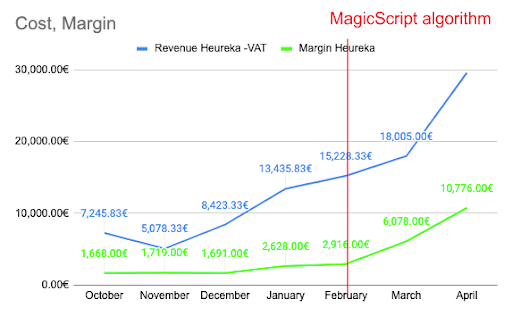The difference between product margin and mark-up in e-commerce
Trade surcharge in e-commerce
The mark-up is a value (usually expressed as a percentage) that expresses the increase in the selling price compared to the purchase price. For example, if the purchase price is € 80 and we add € 20 to it, the selling price will be € 100 with a trade surcharge of 25% (20/80 = 0.25).
Trading margin in e-commerce
Trading margin (or margin) is an expression of the gross profit we have generated in a transaction. It is the difference between the purchase price and the sale price, often expressed as a percentage. If we use our previous example, with a purchase price of € 80 and a sale price of € 100, the trade margin will be 20%.
Here, for example, we can see that the mark-up and margin are two different metrics. It is important that an online store knows the margins of its products because that is precisely what finances the logistics, marketing and day-to-day running of the company. In addition, due to pricing policy and competition, different products often have different percentage margins.

E-commerce growth hack #1: Optimal margin
There are online stores (mainly smaller ones) that set their margin and pricing ‘emotionally’, or in line with the prices of their competition. This is not a sustainable state long-term. In order for any online store to actively manage its growth and profits, it needs order and strategy in its pricing and in its finances.
How to find the margin for individual online products?
The first thing you need to know is the purchase price for each product. Then find out the margin for individual products. The next step is to calculate the total margin for one order, which can consist of several products. Subsequently, we can reduce the margin on the order by adding additional costs, which allows us to find out how much we are willing (and able) to spend on marketing whilst still being profitable.
The basis is to know the purchase price for each product and calculate the absolute margin from one customer order from the difference between purchase and sale.
Margin in the information system
Let’s say we have reached the point where we can calculate the optimal margin, or gross profit for each product or a group of products. In order to be able to use this information meaningfully and automatically, we need to have information about the purchase price and other costs in the information system.
For online stores, this can take the form of a CMS (content management system) or in an ERP (enterprise resource management system).

Application in marketing
Having a margin that’s calculated correctly and having it available within the information system are two basic prerequisites for us to be able to use this resource in marketing. At the very least, it will help us decide which products to advertise and invest money in, and which are not worthwhile and should only be sold organically.
We can use the margin to its greatest benefit when bidding (electronic cost-per-click auction) within advertising systems such as Google, Facebook, or price comparison engines.
E-commerce growth hack #2: Bidding margins in Google Ads
We will now focus on how to use the bidding margin in Google Ads. The easiest use is to have your campaigns broken down to at least margin levels. This is not an exclusive solution, because from a high-margin product campaign, the user can eventually purchase other lower-margin products and vice versa. However, dividing campaigns in this way is better than not taking different margins into account at all.
Here are the three most commonly used methods of importing margin or gross profit into Google Ads:
- Sending the margin value as an event in Google Analytics via Measurement Protocol – this solution is more technically demanding and requires implementation by the online store programmer.
- Submitting a margin value as a transaction value, or as a custom metric when submitting a transaction to Google Analytics – this also requires modifications to be made by the programmer in order to submit data to Google Analytics.
- Margin import using the Magic Script tool, which requires only an XML feed with the order ID and the margin value assigned to it. This method has the added advantage that we can also import margins through the entire history of the online store. This makes the subsequent Google Ads bidding algorithm more accurate.
Once we have submitted the values to Google Ads or uploaded them into the Google Analytics environment, we can use them to set a bidding strategy. In this case, we will not optimize for ROAS; instead, we will opt for the cost-to-margin ratio. The advantage is that we can now redistribute the same budget (which we would have previously optimized for turnover) according to the margin of individual products and thus achieve better profitability of campaigns.

E-commerce growth hack #3: Mind the turnover
When changing the logic of managing PPC advertising (performance marketing) from the point of view of turnover (ROAS) to the gross margin optics (cost to margin ratio), we often encounter the fear that the client will lose turnover. Turnover does not usually decrease with such optimization. The accompanying phenomenon is, in most cases, an increase in the gross margin with a slight increase in turnover, or alternatively its unchanged amount.
Example & calculation
Example: A 2% conversion rate, an average order value from keyword of € 876, an average margin value of 3% Calculation: A 2% conversion rate dictates that the algorithm needs to purchase an average of 50 clicks for each order. If in this case the content contains only one product, for example “robotic lawnmower Chisel 007” with a margin of 3%, it means that the algorithm can spend on average a maximum of 26.28 euros (876 * 0.03 = 26.28) to obtain one order. Since, on average, the algorithm needs to buy 50 clicks for this, it should pay an average of a maximum of 0.52 euros per click (26.28 / 50 = 0.52) If the search for this particular mower is a search and a click on the keyword “robotic mower”, it is only a question of supply and demand as to whether we will be able to buy a sufficient number of clicks.
Let’s not forget, the electronic auction of the price of a click is dynamic and takes place in real time with every single search that a person does on Google. This example must be interpreted on two levels. A relatively low margin (3%) does not automatically mean that bidding on the cost-to-margin ratio will cause advertising for that product to be turned off.
The auction of a click price on Google is dynamic and takes place in real time with every single search that a person makes on Google.
Why is it good for your business?
With a wide portfolio of brands and product categories, the advertising cost management algorithm built in this way responds to the changing market situation in real time. The bidding algorithm simply moves to another keyword that has a lower cost-per-click and may sell another product.
At the end of the day, if your goal is to optimize the overall return on your marketing investment, you should welcome this approach with open arms and focus on a higher goal. And this will lead to the sustainable growth of your online store, which, in the long run, cannot be done with turnover without a profit.
Gross margin and gross profit are the finish line
Bidding on gross margin or gross profit is one of the many steps with which we can move closer towards better profitability and sustainable growth in marketing. The more costs we can clear from the selling price of a product or order, the more accurate our bidding will be. This involves better accounting for delivery costs to different countries, delivery methods, order processing costs, and operating costs.






